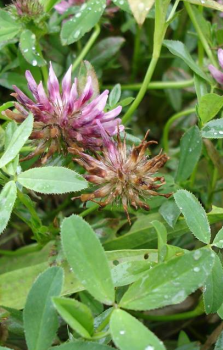Springbank Clover
Common Name: Springbank Clover
Scientific Name: Trifolium wormskjoldiiLehm
Indigenous Name(s):
Perennial clover, Wild clover, Marsh clover, Cows clover, Coast clover Springbank clover root – First Nation’s Names (Nancy Turner, personal communication):
Tlingit: tséit (“wild tubers”) (Thornton)
Haida (Massett, Alaska): ? xil laabs (M)
Haida (Skidegate): naaʔa (naa’a) (rhizomes); naa’a hlk’a’ii (naaʔa łq’aʔii) (plant)
Haisla: t’xwsus (roots); tqw’aas (plant) (introduced to Kitlope by Margaret and Stephen Siwallace of Bella Coola)
Heiltsuk: t’xwsús Oowekyala: t’xwsùs (clover roots)
Kwak’wala (Kwakwaka’wakw): t’əxwsús (clover); t’əkilakw (clover garden; root garden)
Nuu-chah-nulth: ʕaʕiits’u (rhizomes); ʕaʕiits’uqmapt (plant) (Hesquiaht); also used for Trifolium repens)
Ditidaht: naxuu (wild clover, variety); ʕeʕtsiy’
Makah:k’ooxtap ‘suck on it’ (reference to nectar in flowers)
Nuxalk (Salishan): t’xwsus (rhizomes); t’xwsususiixw (plant)
Straits Salish (Saanich): kwłáí’shən (Su51)
Botanical Description
Native herbaceous perennial with tap roots and horizontal rhizomes up to 80cm long, which form extensive patches. Rhizomes are slender and white with fibrous roots arising from their nodes Leaves are bright green, palmately compound with three leaflets (trifoliate) and joined at one point. Leaflets are narrower and longer than those of common lawn clover and additionally sharply saw-toothed. Round flower heads are composed of many pea-like flowers. Flowers are reddish-purple or magenta with white tips and a green jagged sheath at their base. Stems are erect to creeping.
Current Distribution and Local Habitat(s)
Usually growing in wet places, such as wet meadows, salt marshes and stream banks. In BC restricted to tidal meadows, coastal dunes and estuarine flats. Often a dominant species and associated with Pacific Cinquefoil. Extending from the southern Alaska panhandle south to California and Mexico. In BC, Springbank Clover is strictly coastal, rarely found north of Haida Gwaii, while extending inland to alpine meadow areas further south. A healthy population is found on Tl'ches of the Songhees Nation.
Ethnobotanical Application(s)
Springbank clover used to be a very important vegetable-food source for the coastal peoples of BC, including the Haida, the Nuu-chah-nulth (including Dididaht), Nuxalk (Bella Coola), Kwakkwaka’wakw, the Comox, the Straits Salish, the Sechelt, the Haisla and the Makah of Washington.
The clover rhizomes and roots were commonly harvested and prepared together with the roots of Pacific silverweed. The traditional time of harvesting was fall after the leaves had started to die back. Long and pointed digging sticks were used to pry out the roots. Rhizomes were cleaned and spread on mats for several days to allow for drying. They were tied together in bundles for storage. While rarely eaten raw, rhizomes were mostly pit-cooked for immediate use or kept for later use during winter. Practices differed between the coastal aboriginal groups and each had their unique tradition of how to pit-cook and serve the prepared rhizomes. In general, coastal First Peoples differentiated between the short, gnarled, fleshy tap-roots and the long, slender, horizontal rhizomes. Roots and rhizomes were separated during harvest, pit-cooked in separated batches and used according to the various traditions. For example, the Kwakwaka’wakw saved the long rhizomes for high-class families and chiefs at feasts, while the shorter tap-roots were kept for common visitors.
UVic Campus Location(s):
Currently there is no springbank clover on the UVic campus. Introduction of a remnant species found by Fiona Hamersly-Chambers at clover point began in spring 2018 at the Fist People's House, but the stock plants succumbed to wireworms. Restoration is continuing on the same location.
For more information, please visit: https://onlineacademiccommunity.uvic.ca/springbankclover/
Reference(s)
Arnason, J., Hamersley Chambers, F., Karst, A., Kershaw, L., McKinnon, A., Owen, P. (2009). Edible & Medicinal Plants of Canada. Vancouver, BC: Lone Pine Publishing. Pp. 262-263.
Kuhnlein, H.V. & Turner, N. (1991). Traditional Plant Foods of Canadian Indigenous Peoples. Nutrition, Botany and Use. Food and Nutrition in History and Anthropology (ed. Katz, S.). Vol.8. Philadelphia: Gordon and Breach Science Publishers. Pp.197-198.
Turner, N.J. & Royal British Columbia Museum (1995). Food Plants of Coastal First Peoples. Vancouver: UBC Press. Pp.94-95.
Turner, N.J. & D.E. Deur. 1999. Cultivating the clover: Managing plant resources on the Northwest Coast. Presentation at Society of Ethnobiology annual meeting, Oaxaca, Mexico.
Johnson, S. (2014). First Nations Traditional Foods Fact Sheets. First Nation Health Authority, FNHA (Health through Wellness). Retrieved from: http://www.fnha.ca/wellness/wellness-for-first-nations/traditional-wellness/traditional-foods.
Garry Oak Ecosystem Recovery Team (2017). Springbank Clover. Retrieved from: http://www.goert.ca/propagation_guidelines/forbs/trifolium_wormskioldii.
USDA (2017). United States Department of Agriculture, Natural Resource Conservation Service. Plant Guide – Springbank Clover. Retrieved from: https://plants.usda.gov/plantguide/pdf/cs_trwo.pdf.
Project Status:
Year:
Associated Projects:
Image:

